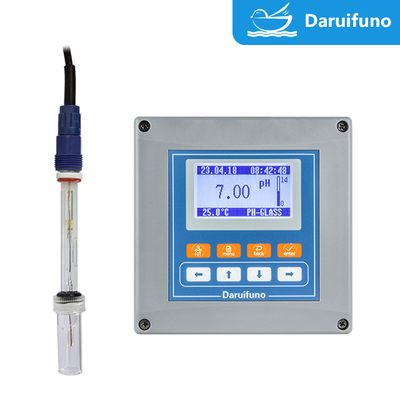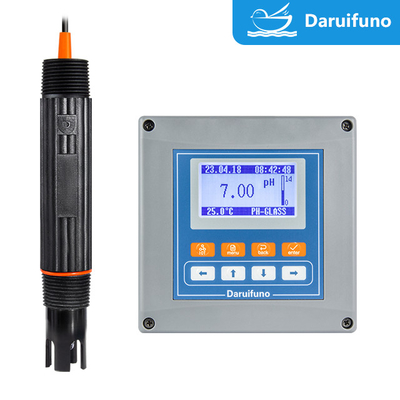Analog PH/ ORP Controller With RS485 Two Relays Control Dosing For Sewage Or Drinking Water
The pH transmitter APX2-C1Z produced by Daruifuno is a device used for measuring and monitoring the acidity (pH value) of solutions, typically employed in industrial process control, laboratory analysis, and environmental monitoring applications. This pH transmitter, equipped with two relay outputs, two current outputs, and one RS485 communication interface, offers the following features and advantages:
Multiple Output Functions:
Two Relay Outputs: These relays can be used for switch control, such as triggering alarms or executing other operations at specific pH values, providing greater flexibility in system control.
Two Current Outputs: The current outputs can be used to transmit pH data to a PLC (Programmable Logic Controller) or data acquisition system for further processing and control.
RS485 Communication Interface:
RS485 is a serial communication protocol known for its high noise tolerance and extended communication range. Utilizing the RS485 interface allows for the transmission of pH data to monitoring systems, computers, or other devices, enabling real-time monitoring and data logging. RS485 also supports multi-point communication, meaning you can connect multiple devices to the same bus, reducing communication costs and complexity.
Real-time Monitoring and Control:
This pH transmitter provides real-time pH value data, enabling quick responses to process changes or issues.
The relays and current outputs can be used for automated control to ensure appropriate actions are taken when pH values deviate from preset ranges.
Flexibility and Adaptability:
Multiple output options and communication interfaces enhance the device's flexibility, making it suitable for various types of applications. RS485 communication allows the device to integrate with other equipment, enabling seamless integration into the entire system.
Data Logging and Analysis:
Through the RS485 interface, you can transmit pH data to a computer or data acquisition system for logging, analysis, and trend chart generation. This aids in monitoring process stability and performance improvement.
Please note that the above information summarizes the key features and advantages of a pH transmitter with the specified capabilities, and the actual device's performance may vary depending on the manufacturer's specifications and model.
Specification:
| Model |
APX2-C1 |
APX2-C1Z |
| Principle |
PH |
Glass pH electrode (hydrogen ion concentration index) |
| ORP |
Platinum or gold electrodes (redox potential) |
| Display Range |
PH |
0~14pH |
| ORP |
± 2000mV |
| Temp |
-10~150℃ |
| Resolution |
PH: 0.01pH ORP: 1mV TEMP: 0.1℃ |
| Accuracy |
0.1% of the measuring range or ±0.02pH / ±2mV, take the larger one |
| Stability |
0.05% of measuring range every 24 hours without accumulation |
| Repeatability |
Better than 0.1% of measuring range |
| Temp Compensation |
Automatic or manual (NTC10K/PT1000) |
| Relay Output |
Two SPST relays, Max. load 3A/250VAC, set high/low alarm, temp or clean control |
| Digital Communication |
—— |
A two-wire RS485 interface, Modbus RTU |
| Current Output |
A 0/4~20mA current Max. load 1000Ω |
| Language |
English |
| Display |
128*64 3.2-inch graphic dot matrix LCD |
| Calibration Method |
PH: 3 points , ORP: 2 points , calibration points can be set freely |
| Protection Grade |
IP66 |
| Enclosure Material |
Enhanced ABS |
| Power Supply |
AC: 100~240V 50/60Hz or DC: 18~36V |
| Dimension |
144*144*120mm (Hole size 138*138mm) |
| Electrical Interface |
Reserve three M12*1.5 glan heads, the wire diameter is 3~6.5mm |
| Work Temperature |
0~60℃, RH<95%, non-condensing |
| Storage Temperature |
-20~70℃, RH<55%, non-condensing |
| Installation |
Wall mounting, pipe clamp, panel |
| Weight |
750g |
| Power Consumption |
Max. 3W |
Brief introduction:
- 3.2 inch LCD screen
- Time and historical data can be recorded
- Temperature compensation function
- 6 Password can be set
- 144*144*120mm dimension
- English interface
- Calibration points are adjust freely



The use environment includes but not limited to the following:
Laboratory environment:
pH and ORP sensors are commonly used in laboratories for chemical analysis, biological experiments and research applications. These environments are often tightly controlled to ensure high precision and accuracy.
Industrial production:
Chemical plants, pharmaceutical plants, food processing plants, and other industrial sites use pH and ORP sensors to monitor and control production processes. This helps ensure product quality, increase production efficiency and avoid unnecessary waste.
Environmental monitoring:
pH and ORP sensors are widely used in the field of environmental monitoring to detect and monitor the properties of water, soil, wastewater and pollutants. This helps protect the natural environment and human health.
Water treatment:
Drinking water treatment plants and wastewater treatment plants use pH and ORP sensors to monitor and regulate the pH and redox properties of water to ensure water quality is up to standard.
Pool and Spa:
pH sensors are used to monitor the pH level of swimming pool and spa water to maintain clean and safe water.
Agriculture:
The field of agriculture uses pH sensors to monitor the pH of the soil to determine the most suitable soil conditions for growing different crops.
Food and drinks:
The food and beverage processing industry uses pH sensors to monitor and regulate the pH of food products to ensure product safety and taste.
Aquarium:
pH and ORP sensors are used to monitor the quality of water in fish tanks, aquariums and aquarium exhibits to ensure the health of fish and aquatic life.
It should be noted that different applications may have different requirements for sensor accuracy, durability and environmental conditions. Therefore, when choosing pH and ORP sensors, you must consider the characteristics of the use environment and choose a suitable sensor model to ensure accurate and reliable measurement.

 Your message must be between 20-3,000 characters!
Your message must be between 20-3,000 characters! Please check your E-mail!
Please check your E-mail!  Your message must be between 20-3,000 characters!
Your message must be between 20-3,000 characters! Please check your E-mail!
Please check your E-mail! 










